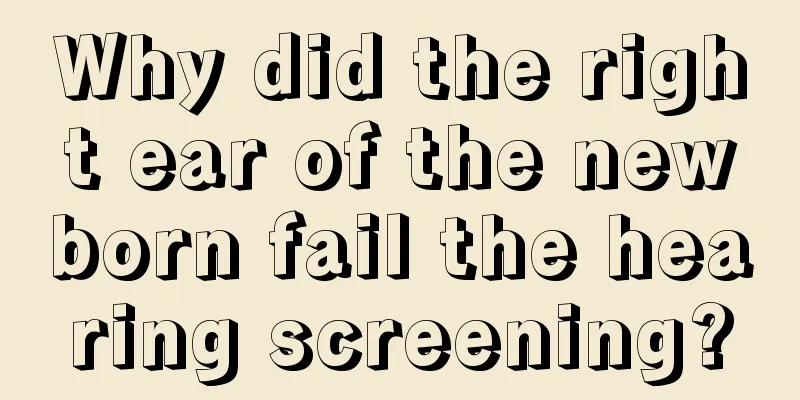Why did the right ear of the newborn fail the hearing screening?

|
It is very necessary to check the hearing of newborns, because it can early detect the potential disease risks in the baby. But what if the newborn fails the hearing screening in the right ear during the hearing screening? What should we do to make up for this and let the baby recover as soon as possible? Hearing screening and re-screening plan Different screening protocols should be used for normal delivery and NICU newborns. 1. Normal delivery: Use screening otoacoustic emissions (OAE) or automated auditory brainstem response (AABR) as the first-line screening tool. All newborns should undergo an initial hearing screening before discharge; those who fail the initial screening should be rescreened within 42 days after birth. When rescreening, both ears should be rescreened. Even if only one ear fails the initial screening, both ears should be rescreened during the rescreening. The re-screening instrument is the same as the primary screening. 2. Newborns and infants admitted to the NICU: If their condition is stable, AABR screening should be performed before discharge to avoid missing retrocochlear hearing loss (such as auditory neuropathy). Infants who fail the AABR test should be referred directly to a hearing center for rescreening and, if appropriate, a comprehensive audiological evaluation including a diagnostic ABR. 3. Infants and young children who are hospitalized again within 1 month of age (regardless of whether they are in the NICU or a general ward): When there is a possibility of delayed hearing loss (such as hyperbilirubinemia with indications for exchange transfusion or sepsis with positive blood culture, etc.), hearing should be rescreened before discharge. 4. In addition to trying to detect existing hearing loss during hearing screening, it is also necessary to analyze the medical history and family history to understand whether the subject has high-risk factors for delayed hearing loss. Those suspected should have their hearing tracked and followed up regularly. The impact of different factors on screening results Studies have shown that the results of hearing screening using OAE or AABR are affected by many factors, mainly including the following aspects: 1. The retention of amniotic fluid, vernix caseosa, and fetal residual material in the external auditory canal during the neonatal period will cause the incoming stimulus sound and outgoing response signals of otoacoustic emissions to attenuate or disappear, thereby leading to the weakening or disappearance of the otoacoustic emission induced signals. Therefore, it is particularly important to clean the external auditory canal with a small cotton swab before screening to keep it clean. In addition, the establishment of screening time is also one of the important factors affecting false positives. Hearing screening too early will lead to an increase in false positives. Domestic and foreign studies have shown that the appropriate time for initial screening is 48 hours after the birth of a newborn. 2. Neonatal middle ear effusion is the main interfering factor affecting the OAE test results. Children with middle ear effusion may have abnormal test results regardless of whether their cochlear function is normal. The author believes that if the screening fails due to middle ear effusion in the newborn, as the middle ear effusion is absorbed, the hearing of some children may return to normal during the diagnostic hearing examination 3 months later. It may be more appropriate to call this situation "positive to negative". 3. The child is physically active or irritable during screening. False positives can occur and should be avoided as much as possible. In addition, if a child is found to have a cold, nasal congestion, runny nose, cough, or hoarseness or heavy breathing sounds, it is recommended to treat them first and wait for the symptoms to improve before re-examining them to avoid false positives. If a child has severe laryngeal stridor and breath sounds, and repeated treatments have not been effective, and there is a real need to understand the child's hearing condition, it is recommended that a diagnostic hearing test be performed directly. 4. Irregularities in technology and operation. For example, the earplug is not fully inserted into the external auditory canal; the wire between the earplug plug and the wire is broken; the test environment does not meet the standards, etc. If the right ear of a newborn fails the hearing screening, further re-examination can be done to avoid misunderstandings caused by examination errors. However, if it is not a misunderstanding, parents are advised to take the baby to some specialized hospitals for treatment. After all, early detection and early treatment will increase the probability of the baby recovering hearing. |
<<: Is a big head in a newborn a disease?
>>: Why does the skin peel off on newborns?
Recommend
What are the symptoms of children getting angry after eating milk powder?
Generally speaking, children will not get inflame...
What should I do if my child's feet are a little bent?
As children grow up, any physical changes will be...
What are the symptoms of milk allergy in children?
Children are in a critical period of physical dev...
Examination and differentiation of scrotal hernia
Scrotal hernia is actually a reproductive disease...
Urinary tract infection in little boy
Urinary tract infection in little boys is a commo...
White spots in infants' mouths
If there are white spots in the mouth of infants ...
How to educate children as a single mother
Education has always been a key issue in our coun...
Why is the child so thin?
Many parents will find that their children usuall...
Why does my one month old baby have a white tongue coating?
It is quite common for one-month-old babies to ha...
Is it good for children to sleep on buckwheat pillows?
Sleep is a necessity for us every day. Only with ...
What is the reason why babies sweat and wet pillows when sleeping?
Babies sweat a lot when they sleep, even their pi...
What kind of milk is good for children
When children are young, their diet needs to be a...
Signs of baby's growth
Generally speaking, the baby's infant period ...
How to bathe a newborn baby?
Newborn babies need to be bathed frequently becau...
Can children eat watermelon if they have sore throat?
A baby is the future of a family, and the healthy...









